 | |
|
This article is part of the series on: Military of ancient Rome 753 BC – AD 476 | |
| Structural history | |
|---|---|
| Roman army (unit types and ranks, legions, auxiliaries, generals) | |
| Roman navy (fleets, admirals) | |
| Campaign history | |
| Lists of wars and battles | |
| Decorations and punishments | |
| Technological history | |
| Military engineering (castra, siege engines, arches) | |
| Political history | |
| Strategy and tactics | |
| Infantry tactics | |
| Frontiers and fortifications (limes, Hadrian's Wall) | |

Tropaeum Traiani 1977 reconstruction
The Tropaeum Traiani is a monument in Roman Civitas Tropaensium (site of modern Adamclisi, Romania), built in 109 in then Moesia Inferior, to commemorate Roman Emperor Trajan's victory over the Dacians, in 102, in the Battle of Tapae. Before Trajan's construction, an altar existed there, on the walls of which were inscribed the names of the 3,000 legionaries and auxilia (servicemen) who had died "fighting for the Republic". (Latin: Tropaeum from Greek: Tropaion, source of English: "trophy").
Trajan's monument was inspired by the Augustus mausoleum, and was dedicated to the god Mars Ultor in 107/108 AD. On the monument there were 54 metopes depicting Roman legions fighting against enemies; most of these metopes are preserved in the museum nearby. The monument was supposed to be a warning to the tribes outside this newly conquered province.[1]
By the 20th century, the monument was reduced to a mound of stone and mortar, with a large number of the original bas-reliefs scattered around. The present edifice is a reconstruction dating from 1977. The nearby museum contains many archaeological objects, including parts of the original Roman monument. Of the original 54 metopes, 48 are in the museum and 1 is in Istanbul.
Trophy[]
The monument was decorated with a large inscription dedicated to Mars Ultor (the avenger). The inscription has been preserved fragmentarily from two sides of the trophy hexagone, so it could be reconstructed as follows:
MARTI ULTOR[I]
IM[P(erator)CAES]AR DIVI
NERVA[E] F(ILIUS) N[E]RVA
TRA]IANUS [AUG(USTUS) GERM(ANICUS)]
DAC]I[CU]S PONT(IFEX) MAX(IMUS)
TRIB(UNICIA) POTEST(ATE) XIII
IMP(ERATOR) VI CO(N)S(UL) V P(ater) P(atriae)
?VICTO EXERC]ITU D[ACORUM]
?---- ET SARMATA]RUM
----]E 31.[2]
The inscription from the main monument can be translated in this way:
"To Mars, the avenger, Caesar the emperor, son of divine Nerva, Nerva
Trajan, Augustus, who defeated the Germans, the Dacians, great priest, for the 13th time tribune of the plebeians, proclaimed emperor by the army for the 6th time, elected consul for the 5th time, father of our homeland,
after defeating the Dacian and the Sarmatian armies."
Metopes[]
On the monument was a frieze comprising 54 metopes. 48 metopes are hosted in the Adamclisi museum nearby, and one metope is hosted by Istanbul Archaeology Museum, the rest having been lost (There is a reference from Giurescu that two of them fell into Danube River during the transport to Bucharest).[3]
Roman General Tomb[]
Legionaries Memorial[]
"in honorem et in memoriam fortissimorum virorum qui pugnantes pro republica morte occubuerunt" [2]
1977 Reconstruction[]
The monument was restored based on a hypothetical reconstruction in 1977.
Archeological research[]
- The monument was mentioned in 1801 by William Bentinck, still the manuscript was first published in 1874.
- In 1837, four prussian officers, hired by the Otoman Empire to study the Dobruja strategic situation, performs the first escavations. The team was composed by Heinrich Muhlbach, leading Friedrich Leopold Fischer, Carol Wincke-Olbendorf and Helmuth von Moltke the Elder. They have tried to reach the center of the monument by digging an underground tunnel, nothing was found after the digging.[4]
- The monument is also visited by C. W. Wutzer from Bonn University, who make a short description of the monument and of some local legends.[4]
- The monument was researched by Grigore Tocilescu, O. Benford and G. Niemann, between 1882–1895,[6] George Murnu in 1909, Vasile Parvan stop the researches in 1911, Paul Nicorescu has studied the site between 1935–1945, Gheorghe Stefan and Ioan Barnea in 1945. From 1968 the site is researched under Romanian Academy supervision.
Civitas Tropaensium[]
The name of the site was given after the monument, the ancient name of the city is unknown.[citation needed]
Notes[]
- ↑ F.B Florescu Das Siegesdenksmal von Adamclisi: Tropaeum Traiani (1965)
- ↑ 2.0 2.1 http://cimec.ro/Arheologie/tropaeum/introen/body.html
- ↑ http://romaniancoins.org/10lei09_adamclisi.html
- ↑ 4.0 4.1 4.2 4.3 4.4 4.5 Vasile Barbu, Cristian Schuster Grigore G. Tocilescu si "Cestiunea Adamclisi" Pagini din Istoria Arheologiei Romanesti ISBN 7-379-25580-0
- ↑ http://www.archive.org/details/dastropaionvonad00furtuoft
- ↑ Cimec http://www.cimec.ro/scripts/muzee/id.asp?k=246
References[]
- Das Tropaion von Adamklissi und provinzialrömische Kunst. Von Adolf Furtwängler ... (München, Verlag der K. Akademie, 1903), by Adolf Furtwängler http://www.archive.org/details/dastropaionvonad00furtuoft
- Florea Bobu Florescu, Das Siegesdenkmal von Adamklissi. Tropaeum Traiani. Akademieverlag, Bukarest 1965.
- Wilhelm Jänecke, Die ursprüngliche Gestalt des Tropaion von Adamklissi. Winter, Heidelberg 1919.
- Adrian V. Rădulescu, Das Siegesdenkmal von Adamklissi. Konstanza 1972 und öfter.
- Ian A. Richmond: Adamklissi, en Papers of the British School at Rome 35, 1967, p. 29–39.
- Lino Rossi, A Synoptic Outlook of Adamklissi Metopes and Trajan’s Column Frieze. Factual and Fanciful Topics Revisited, en Athenaeum 85, 1997, p. 471–486.
- http://arche-o.nolblog.hu/page/2/
External links[]
| Wikimedia Commons has media related to Tropaeum Traiani. |
Coordinates: 44°06′07″N 27°57′18″E / 44.102°N 27.955°E
The original article can be found at Tropaeum Traiani and the edit history here.


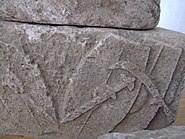













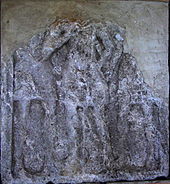





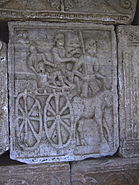





![AdamclisiMetope25.jpg (2.44 MB) Metope XXII: Emperor Trajan.[4]](https://upload.wikimedia.org/wikipedia/commons/thumb/0/06/AdamclisiMetope25.jpg/139px-AdamclisiMetope25.jpg)





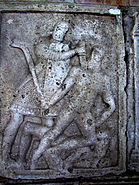
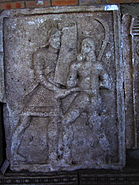
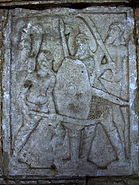







![AdamclisiMetope42.jpg (1.71 MB) Emperor Trajan with a Lieutenant.[4]](https://upload.wikimedia.org/wikipedia/commons/thumb/b/b0/AdamclisiMetope42.jpg/153px-AdamclisiMetope42.jpg)












![MetopeAdamclisi10.jpg (2.29 MB) Sarmatian, captives in the war against the Romans.[4]](https://upload.wikimedia.org/wikipedia/commons/thumb/1/19/MetopeAdamclisi10.jpg/139px-MetopeAdamclisi10.jpg)












![Adolffurtwangleradamclisi006.jpg (44 KB) Adolf Furtwangler picture [5]](https://upload.wikimedia.org/wikipedia/commons/thumb/f/fc/Adolffurtwangleradamclisi006.jpg/185px-Adolffurtwangleradamclisi006.jpg)


